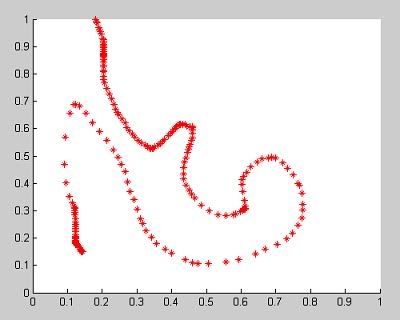Here's an example of how you can do this conversion...
Let's say you have a figure, and that figure contains an axes object with handle hAxes. Using the function GINPUT would allow you to select points within the axes. To get an equivalent set of points from get(0,'PointerLocation'), which gives coordinates in relation to the screen, you have to account for the figure position, axes position, axes width/height, and axes limits.
Doing this is tricky because you want to have the position measures in the same units. If you want to compute everything in units of pixels, this means you'd have to set the 'Units' properties of the objects to 'pixels', get the positions, then set the 'Units' properties back to what they previously were. I usually make my own function get_in_units to do this part:
function value = get_in_units(hObject,propName,unitType)
oldUnits = get(hObject,'Units'); %# Get the current units for hObject
set(hObject,'Units',unitType); %# Set the units to unitType
value = get(hObject,propName); %# Get the propName property of hObject
set(hObject,'Units',oldUnits); %# Restore the previous units
end
Using the above function, you can make another function get_coords which gets the screen coordinates and converts them to axes coordinates:
function coords = get_coords(hAxes)
%# Get the screen coordinates:
coords = get_in_units(0,'PointerLocation','pixels');
%# Get the figure position, axes position, and axes limits:
hFigure = get(hAxes,'Parent');
figurePos = get_in_units(hFigure,'Position','pixels');
axesPos = get_in_units(hAxes,'Position','pixels');
axesLimits = [get(hAxes,'XLim').' get(hAxes,'YLim').'];
%# Compute an offset and scaling for coords:
offset = figurePos(1:2)+axesPos(1:2);
axesScale = diff(axesLimits)./axesPos(3:4);
%# Apply the offsets and scaling:
coords = (coords-offset).*axesScale+axesLimits(1,:);
end
The resulting coords should be close to those you would get from using GINPUT. Note that if the axes object is nested within any uipanel objects in the figure, you will have to account for the panel positions as well.
Example:
To illustrate the behavior of the above code, here's a neat little example. After creating the above functions, create this third function:
function axes_coord_motion_fcn(src,event,hAxes)
coords = get_coords(hAxes); %# Get the axes coordinates
plot(hAxes,coords(1),coords(2),'r*'); %# Plot a red asterisk
end
Then run the following code:
hFigure = figure; %# Create a figure window
hAxes = axes; %# Create an axes in that figure
axis([0 1 0 1]); %# Fix the axes limits to span from 0 to 1 for x and y
hold on; %# Add new plots to the existing axes
set(hFigure,'WindowButtonMotionFcn',... %# Set the WindowButtonMotionFcn so
{@axes_coord_motion_fcn,hAxes}); %# that the given function is called
%# for every mouse movement
And when you move the mouse pointer over the figure axes, you should see a trail of red asterisks being plotted behind it, like so:

